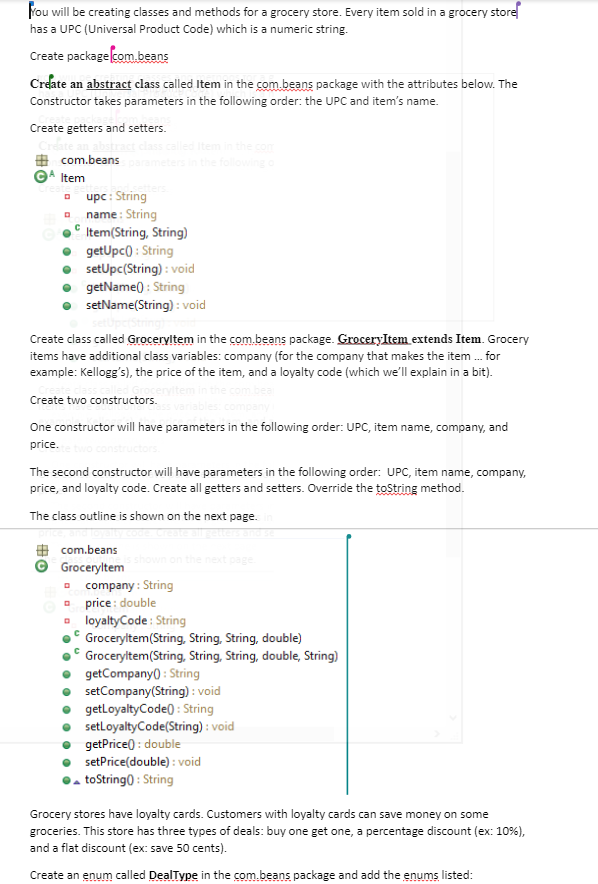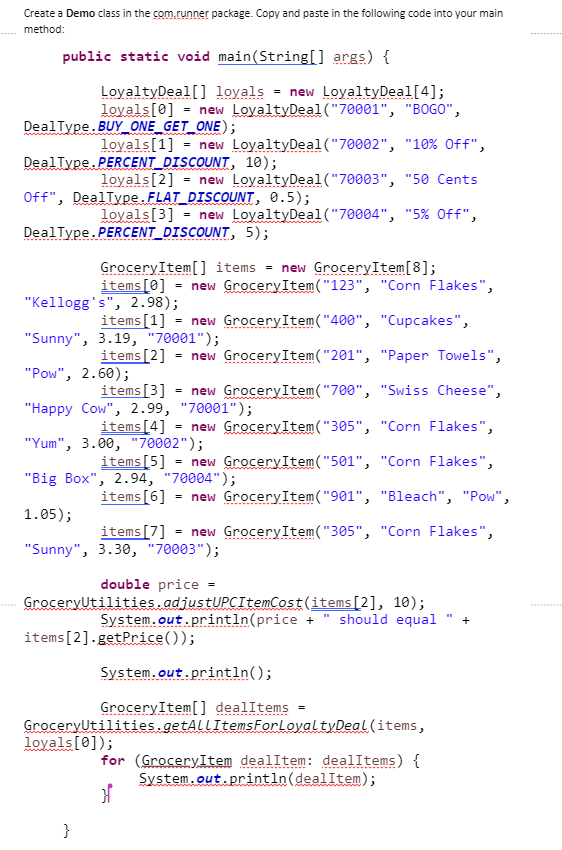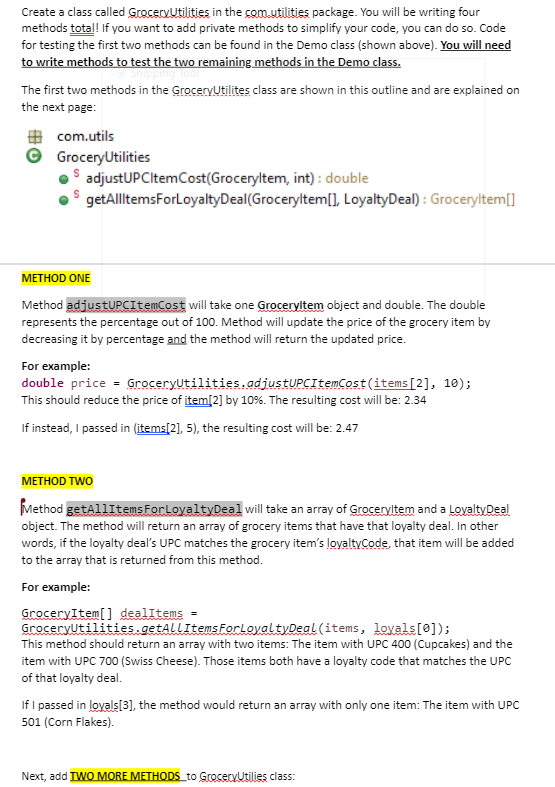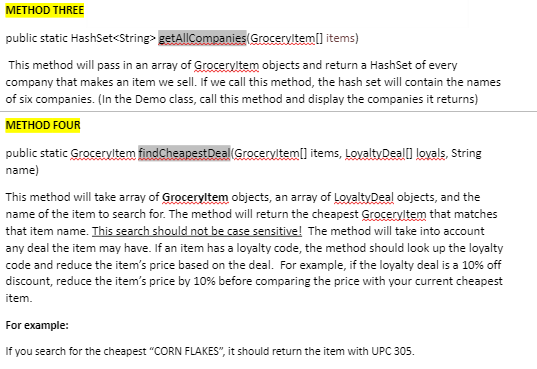Answered step by step
Verified Expert Solution
Question
1 Approved Answer
Please do in Java. Thank you Fou will be creating classes and methods for a grocery store. Every item sold in a grocery store has





Please do in Java. Thank you
Fou will be creating classes and methods for a grocery store. Every item sold in a grocery store has a UPC (Universal Product Code) which is a numeric string. Create package com beans Create an abstract class called Item in the com.beans package with the attributes below. The Constructor takes parameters in the following order: the UPC and item's name. Create getters and setters. # com.beans Item upc: String .name : String Item(String, String) .getUpc(): String setUpc(String): void .getName(): String setName(String): void Create class called Groceryltem in the com.beans package. GroceryItem extends Item. Grocery items have additional class variables: company (for the company that makes the item ... for example: Kellogg's), the price of the item, and a loyalty code (which we'll explain in a bit). Create two constructors. One constructor will have parameters in the following order: UPC, item name, company, and price. The second constructor will have parameters in the following order: UPC, item name, company, price, and loyalty code. Create all getters and setters. Override the toString method. The class outline is shown on the next page. # com.beans Groceryltem e company: String . price: double loyaltyCode: String Groceryltem(String. String, String, double) Groceryltem(String, String, String, double, String) getCompany: String setCompany(String): void .getLoyaltyCode(): String SetLoyaltyCode(String): void getPrice: double setPrice(double): void toString(): String Grocery stores have loyalty cards. Customers with loyalty cards can save money on some groceries. This store has three types of deals: buy one get one, a percentage discount (ex: 10%), and a flat discount (ex: save 50 cents). Create an enum called DealType in the com.beans package and add the enums listed: com.beans DealType SF BUY_ONE_GET_ONE SF PERCENT_DISCOUNT SF FLAT_DISCOUNT Every loyalty deal has a UPC associated to it and a name for the type of deal it is. Create a LoyaltyDeal class in the com.beans. LoyaltyItem extends Item.. Loyalty deals have additional class variables: A deal type and a discount value. Create two constructors. One constructor will have parameters in this order: UPC, name, and deal type. The other constructor will have parameters in this order: UPC, name, deal type, and discount. Create getters and setters and override toString. The class outline is on the next page. # com.beans LoyaltyDeal . dealType: DealType discount : double LoyaltyDeal(String, String, DealType) LoyaltyDeal(String, String, DealType double) getDealType(): DealType setDealType(DealType) : void getDiscount(): double set Discount(double): void toString(): String Create a Demo class in the com.runner package. Copy and paste in the following code into your main method: public static void main(String[] args) { LoyaltyDeal] loyals = new LoyaltyDeal[4]; loyals[0] = new LoyaltyDeal ("70001", "BOGO", DealType.BUY_ONE_GET_ONE); loyals[1] new LoyaltyDeal("70002", "10% Off", DealType.PERCENT_DISCOUNT, 10); loyals[2] = new LoyaltyDeal ("70003", "50 Cents Off", DealType.FLAT_DISCOUNT, 0.5); loyals[3] = new LoyaltyDeal ("70004", "5% Off", DealType. PERCENT_DISCOUNT, 5); GroceryItem[] items = new GroceryItem[8]; items [0] = new Grocery Item("123", "Corn Flakes", "Kellogg's", 2.98); items[1] new Grocery Item("400", "Cupcakes", "Sunny", 3.19, "70001"); items [2] = new GroceryItem("201", "Paper Towels", "Pow", 2.60); items [3] = new Grocery Item("700", "Swiss Cheese", "Happy Cow", 2.99,"70001"); items [4] = new Grocery Item("305", "Corn Flakes", "Yum", 3.00, "70002"); items [5] = new Grocery Item("501", "Corn Flakes", "Big Box", 2.94, "70004"); items[6] = new Grocery Item("901", "Bleach", "Pow", 1.05); items [7] = new Grocery Item("305", "Corn Flakes", "Sunny", 3.30, "70003"); double price = GroceryUtilities. adjustUPCItemCost(items[2], 10); System.out.println(price + " should equal items [2].getPrice); + System.out.println(); Grocery Item[] dealItems = GroceryUtilities.getALlItemsForLoyaltyDeal (items, loyals[0]); for (GroceryItem dealItem: dealItems) { System.out.println(dealItem); } METHOD THREE public static HashSetStep by Step Solution
There are 3 Steps involved in it
Step: 1

Get Instant Access to Expert-Tailored Solutions
See step-by-step solutions with expert insights and AI powered tools for academic success
Step: 2

Step: 3

Ace Your Homework with AI
Get the answers you need in no time with our AI-driven, step-by-step assistance
Get Started


